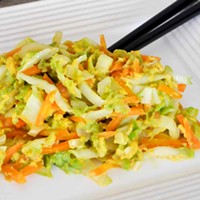I learned as much about growing cabbage, corn and zucchini as I did about my neighbors while volunteering at the Happy Forever Community Garden in Berkeley 10 years ago. Calling the 12-by-18-foot traffic diverter on a side street a community garden was a bit of a stretch but the barren diverter-turned-food-producing island taught me a lot.
A community garden relates to a community in three ways. It's an enterprise that belongs to the community, the group of people who organize themselves and manage the space. The garden also creates a community: It attracts not only pollinators but people. Every time I worked in the garden, neighbors stopped by and let me know how much they appreciated the work we did. I enjoyed offering them bunches of basil, handfuls of snap beans, a few cherry tomatoes to savor while walking home. One afternoon I astounded a child visiting from the U.K. by giving him a couple of lemon cucumbers and watched him scamper away, eager to show the yellow treasures to his mother. The day we planted asparagus crowns, a woman and her elderly father stopped by. Originally from Iran, he had left his garden behind and missed it deeply. While his daughter was telling their story, he showed me how to prepare the ground for the crowns. He did not speak English so I grinned my thanks.
Finally, to thrive the garden needs a community committed to it. Like farmers markets and community-supported agriculture (CSA), community gardens are rooted in many areas, included our county. If you want to know where the nearest one to you is, the Local Gardens page of the North Coast Community Garden Collaborative website at www.northcoastgardens.org provides a listing that includes contacts. The same organization publishes the monthly e-newsletter Gardening Gazette, with local community garden news and a list of upcoming events. Visit a garden near you, see how it is organized, get involved.
I readily admit that the most exciting part of my volunteer experience was harvesting what we had planted and tended. I fell in love with Brussels sprouts and scarlet runner beans, marveled at the productivity of bush beans and never got tired of bringing home summer squashes and zucchini.
Debbie Perticara, a North Coast Community Garden Collaborative staff member and senior planner for the Natural Resources Services division of the Redwood Community Action Agency, says the most frequently grown vegetables and fruits in Humboldt County community gardens are carrots, lettuces, spinach, broccoli, peas, kale, Swiss chard, strawberries, zucchini and onions.
Of those, right now community gardeners might be harvesting carrots, lettuces, spinach, broccoli, kale, Swiss chard and onions. As we all know, coastal and inland climate are quite different, so crops and harvest times vary depending on garden locations. Tomatoes, peppers, corn and eggplant grow well inland, but they are more difficult to grow on the coast, where cool season crops grow well year-round.
Below is a suggestion for putting your community garden's harvest to good use. Not a gardener? Don't worry — you can prepare the recipe with ingredients grown by someone else.
"One who plants a garden, plants happiness", says a Chinese proverb. Imagine the possibilities when it is a whole community planting that garden.
Wortelstoemp
This is my version of a popular Belgian dish. Stoemp is a mixture of mashed potatoes and vegetables. The version with potatoes and carrots is called Wortelstoemp. Serves 6.
Ingredients:
13½ ounces potatoes
12 ounces carrots (orange or rainbow)
2 tablespoons extra-virgin olive oil
2 medium leeks, white and light green portion (set aside the dark green portion to make broth or stock)
Leaves of several sprigs of fresh thyme
2 garlic cloves, minced
2 spring onions, white and light green portion
1/8 teaspoon of fine sea salt
1/8 teaspoon of lemon zest
2 tablespoons of vegetable broth or chicken stock or broth
¼ teaspoon of fine sea salt
1 pinch of grated nutmeg
1 pinch of freshly ground black pepper
Scrub the potatoes and boil in plenty of water until tender. Drain and let cool. When they are cool enough to handle, peel them and place in a bowl. Mash them with a potato masher.
Scrub and skin the carrots. Cut each into 2-3 pieces. Cover them in water and boil until tender. Drain and let cool slightly. Reserve a tablespoon of the cooking water. Mash the carrots with a potato masher.
After trimming the roots, cut the leeks in half lengthwise and slice them into 1/8-inch-thick half-moons. Rinse them in a colander, then place them in a bowl and fill it with cold water. With your hands, swirl the leeks to clean them well, then scoop them out of the water with a sieve or slotted spoon and drain them in a colander.
Cut the spring onions in half lengthwise and slice into 1/8-inch-thick half-moons. Rinse well in a small colander.
Over medium heat, warm the olive oil in a large skillet (large enough to later hold the mashed carrots and potatoes). Add the leeks and stir to coat, then add the thyme and stir again. Cook the leeks for a couple of minutes. Cover the skillet and cook on low heat until the leeks are soft (8 minutes or so), stirring every now and then.
Add the garlic to the skillet, stir, cover again and cook for 2 minutes. Add the spring onions, stir, cover again and cook for another 2 minutes.
Season with the lemon zest and 1/8 teaspoon of sea salt and stir.
Add the mashed carrots and potatoes to the skillet, still on low heat. Stir well. Add 1 tablespoon of the carrot cooking water and the broth or stock, and stir.
Sprinkle ¼ teaspoon of sea salt, the black pepper and nutmeg, and stir well. Serve warm.
Simona Carini also writes about her adventures in the kitchen on her blog www.pulcetta.com



Comments (2)
Showing 1-2 of 2